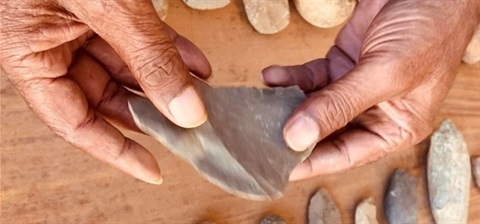Stone tools

Wiradjuri manufactured a range of stone tools providing evidence of tens of thousands of years of our occupation in the Parkes area. As stone artefacts do not perish, they are often the only evidence of Wiradjuri in our area. Stone tools tell the story of where our Ancestors lived and how they used the land.
Tools were used for agricultural purposes in tilling of soil, cultivation and harvesting of roots and vegetables. Other domestic tools were used for chopping, grinding, cutting, and pounding, as well as for ceremonial and trade purposes.
Stone for these tools was sourced from local quarries in rocky outcrops. Many stone artefacts that have been found in this area are made from stone types that do not occur locally. They must have been carried long distances and gifted or traded by Ancestors.
Grinding stones
Walamwunga Grinding stone
Grinding stones come in a range of sizes from very small and portable, to very large. Our Ancestors left the larger grinding stones at a site for future use on return visits for seasonal harvesting of particular plants. The stones are sometimes found upside down, with the grinding surface facing the ground to preserve it from the weather. Walamwunga were often made from abrasive rocks such as sandstone or coarse-grained basalt or quartzite. Used to grind and process grains, seeds and many types of food for cooking. They were also used to crush ochre into pigment for ceremonies and the decoration of objects.
Spears and stone tools were often sharpened on rocks leaving grooves. Evidence of these grinding grooves can be found throughout the local area.
Guwingal stone axes
Stone axes are usually round or oval in shape with cutting edges formed by grinding. Some have been polished smooth and may have been designed to have a handle with a groove around them. The wooden handle was attached to the axe head using natural resin and plant fibre or kangaroo sinew.
Axe blanks are unfinished axe heads. Our Ancestors sourced the blanks from rocky outcrops or traditional quarries and then shaped them through grinding to make a sharp cutting edge.
Stone axes were primarily agricultural tools used to chop down small trees, chop wood, remove bark for canoes and shelters, and butcher animals. They were also used as weapons, ceremonial objects and valuable items for trade.
Stone flakes
Our Ancestors made stone tools by hitting a block of stone known as a core, with a bumal hammer stone creating sharp edges. This process is now known as knapping. The sharp fragments of stone are called flakes or microliths, which have been shaped into a point or scraper. The cores were generally fist sized or smaller with scars where the flakes have been removed. These flake stone tools had many uses such as sharpening objects, spear-tips for hunting weapons, scraping and preparing animal skins, wood carving, and as knives. The flake tools were re-touched or sharpened and shaped when the tool became blunt through use.
Bogan pick
A Wiradjuri stone tool, cone shaped with a pointed tip at one end, a rounded base and a groove around the circumference at the centre of the stone, possibly for attaching a wooden handle. The Bogan River Pick was used for ploughing and soil cultivation using a pendulum motion.